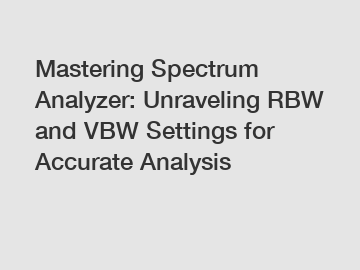Dec. 23, 2023
Electrical Equipment
For more information, please visit SUIN.
Mastering Spectrum Analyzer: Unraveling RBW and VBW Settings for Accurate Analysis.
Spectrum analyzers play a crucial role in signal analysis and troubleshooting in various fields, including telecommunications, electronics, and RF engineering. These analytical tools allow us to visualize and study the frequency spectrum of signals, aiding in the identification and resolution of issues. However, to achieve accurate analysis, it is essential to understand and optimize two critical parameters: Resolution Bandwidth (RBW) and Video Bandwidth (VBW). In this article, we will delve into the origins of RBW and VBW, discuss their significance, and explore their impact on spectrum analysis.

RBW, short for Resolution Bandwidth, determines the ability of a spectrum analyzer to discern and separate closely spaced signals. It refers to the frequency span that an instrument uses to measure signals. Essentially, a smaller RBW indicates better frequency resolution, enabling the detection of narrowband signals or variations in signal characteristics. On the other hand, a larger RBW is suitable for capturing broader spectral content or analyzing signals with wider bandwidths. Therefore, selecting an appropriate RBW setting is crucial to ensure accurate analysis and prevent the loss of vital signal information.
The selection of RBW is closely related to the concept of frequency resolution. The frequency resolution is inversely proportional to the RBW. That is, a smaller RBW results in higher frequency resolution, allowing us to identify and analyze signals with greater precision. This improved precision is especially essential in scenarios where there are multiple closely spaced signals or when analyzing the characteristics of modulation schemes, such as sidebands or carrier frequencies. In contrast, a larger RBW sacrifices frequency resolution but enhances sensitivity, making it suitable for capturing weaker signals or signals with wider bandwidths. The trade-off between frequency resolution and signal capture capacity makes RBW a critical parameter to carefully optimize.
VBW, or Video Bandwidth, represents the bandwidth within which the spectrum analyzer performs signal averaging. It determines the sensitivity and measurement speed of the instrument. By setting the VBW appropriately, we can balance the accuracy of measurements and the responsiveness of the analyzer. A lower VBW provides better measurement accuracy and detail as it averages signals over a narrower bandwidth, reducing noise and improving the signal-to-noise ratio. However, this comes at the expense of increased measurement time. Conversely, a higher VBW allows for faster measurements but may sacrifice accuracy, smoothing out smaller variations and potentially missing important details.
Optimizing RBW and VBW settings in a spectrum analyzer is crucial for accurate analysis and interpretation of signals. By selecting an appropriate RBW, we can achieve the desired resolution and detect closely spaced signals. Simultaneously, adjusting the VBW helps strike a balance between measurement accuracy and speed, enabling efficient analysis while maintaining sufficient detail. It is worth noting that RBW and VBW settings depend on the specific requirements of the application and the characteristics of the signal in question.
In conclusion, mastering the RBW and VBW settings of a spectrum analyzer is essential for accurate signal analysis. Understanding the origins and impact of RBW and VBW allow us to optimize these parameters accordingly, ensuring reliable measurements and precise analysis. By unraveling the complexities of RBW and VBW settings, we can unlock the full potential of spectrum analyzers and enhance our ability to unravel the intricacies of signal analysis.
If you are looking for more details, kindly visit Spectrum Analyzer Is Used For.
If you are interested in sending in a Guest Blogger Submission,welcome to write for us!
All Comments ( 0 )